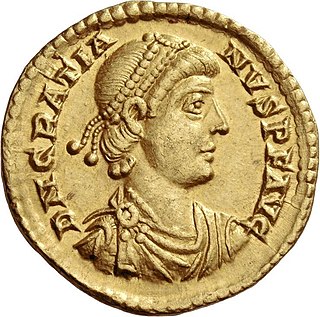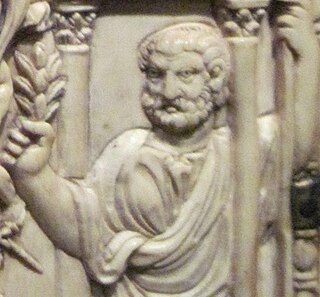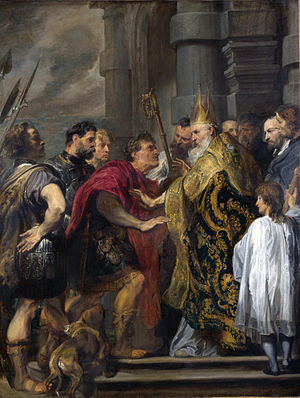Ambrose of Milan, venerated as Saint Ambrose, was the Bishop of Milan, a theologian, and one of the most influential ecclesiastical figures of the 4th century.

Theodosius I, also called Theodosius the Great, was Roman emperor from 379 to 395. During his reign, he faced and overcame a war against the Goths and two civil wars, and was key in establishing the creed of Nicaea as the universal orthodoxy for Christianity. Theodosius was also the last to unite the whole Roman Empire under his rule before its administration was permanently split between two separate western and eastern courts.

Gratian was emperor of the western part of the Roman Empire from 367 to 383. The eldest son of Valentinian I, Gratian accompanied his father on several campaigns along the Rhine and Danube frontiers and was raised to the rank of augustus in 367. Upon the death of Valentinian in 375, Gratian took over government of the west while his half-brother Valentinian II was also acclaimed emperor in Pannonia. Gratian governed the western provinces of the empire, while his uncle Valens was already the emperor over the east.

Valentinian II was a Roman emperor in the western part of the Roman empire between AD 375 and 392. He was at first junior co-ruler of his brother, was then sidelined by an usurper, and only after 388 sole ruler, be it with limited de facto powers.
Flavius Theodosius, also known as Count Theodosius or Theodosius the Elder, was a senior military officer serving Valentinian I and the western Roman empire during Late Antiquity. Under his command the Roman army defeated numerous threats, incursions, and usurpations. Theodosius was patriarch of the imperial Theodosian dynasty and father of the emperor Theodosius the Great.

Quintus Aurelius Symmachus "Eusebius" was a Roman statesman, orator, and man of letters. He held the offices of governor of proconsular Africa in 373, urban prefect of Rome in 384 and 385, and consul in 391. Symmachus sought to preserve the traditional religions of Rome at a time when the aristocracy was converting to Christianity, and led an unsuccessful delegation of protest against Gratian, when he ordered the Altar of Victory removed from the curia, the principal meeting place of the Roman Senate in the Forum Romanum. Two years later he made a famous appeal to Gratian's successor, Valentinian II, in a dispatch that was rebutted by Ambrose, the bishop of Milan. Symmachus's career was temporarily derailed when he supported the short-lived usurper Magnus Maximus, but he was rehabilitated and three years later appointed consul. After the death of Theodosius I, he became an ally of Stilicho, the guardian of emperor Honorius. In collaboration with Stilicho he was able to restore some of the legislative powers of the Senate. Much of his writing has survived: nine books of letters; a collection of Relationes or official dispatches; and fragments of various orations.

The Theodosian dynasty was a Roman imperial family that produced five Roman emperors during Late Antiquity, reigning over the Roman Empire from 379 to 457. The dynasty's patriarch was Theodosius the Elder, whose son Theodosius the Great was made Roman emperor in 379. Theodosius's two sons both became emperors, while his daughter married Constantius III, producing a daughter that became an empress and a son also became emperor. The dynasty of Theodosius married into, and reigned concurrently with, the ruling Valentinianic dynasty, and was succeeded by the Leonid dynasty with the accession of Leo the Great.

The Battle of the Frigidus, also called the Battle of the Frigid River, was fought between 5 and 6 September 394 between the army of the Roman emperor Theodosius the Great and the army of the rebel augustus Eugenius, in the eastern border of Regio X in Roman Italia. Theodosius won the battle and defeated the usurpation of Eugenius and Arbogast, restoring unity to the Roman Empire. The battlefield, in the Claustra Alpium Iuliarum near the Julian Alps through which Theodosius's army had passed, was probably in the Vipava Valley – with the Frigidus River being the modern Vipava – or possibly in the valley of the Isonzo.

The Altar of Victory was located in the Roman Senate House and bore a gold statue of the goddess Victory. The altar was established by Octavian in 29 BC to commemorate the defeat of Antony and Cleopatra at the Battle of Actium.

The Valentinianic or Valentinian dynasty was a ruling house of five generation of dynasts, including five Roman emperors during Late Antiquity, lasting nearly a hundred years from the mid fourth to the mid fifth century. They succeeded the Constantinian dynasty and reigned over the Roman Empire from 364 to 392 and from 421 to 455, with an interregnum (392–423), during which the Theodosian dynasty ruled and eventually succeeded them. The Theodosians, who intermarried into the Valentinian house, ruled concurrently in the east after 379.

As the Roman Republic, and later the Roman Empire, expanded, it came to include people from a variety of cultures, and religions. The worship of an ever increasing number of deities was tolerated and accepted. The government, and the Romans in general, tended to be tolerant towards most religions and religious practices. Some religions were banned for political reasons rather than dogmatic zeal, and other rites which involved human sacrifice were banned.
Arbogastes or Arbogast was a Roman army officer of Frankish origin.

Religion in the Greco-Roman world at the time of the Constantinian shift mostly comprised three main currents:
Virius Nicomachus Flavianus was a grammarian, a historian and a politician of the Roman Empire.
The Edict of Thessalonica, issued on 27 February AD 380 by three reigning Roman Emperors, made Nicene Christianity the state religion of the Roman Empire. It condemned other Christian creeds such as Arianism as heresies of madmen, and authorized their persecution.

Persecution of pagans in the late Roman Empire began during the reign of Constantine the Great (306–337) in the military colony of Aelia Capitolina (Jerusalem), when he destroyed a pagan temple for the purpose of constructing a Christian church. Christian historians alleged that Hadrian had constructed a temple of Aphrodite on the site of the crucifixion of Jesus on Golgotha hill in order to suppress Jewish Christian veneration there. Constantine used that to justify the temple's destruction, saying he was simply reclaiming the property. Constantine and those who followed him instituted many anti-pagan laws. For example, in 341, Constantine's son Constantius II enacted legislation forbidding pagan sacrifices in Roman Italy. In 356, he issued two more laws forbidding sacrifice and the worship of images, making them capital crimes, as well as ordering the closing of all temples. In 357, Constantius visited Rome, and in preparation for his visit, so he would not be faced with being expected to offer a sacrifice on the Altar by his pagan senators, Constantius ordered the Altar of Victory to be removed from the Senate. The statue of victory was allowed to remain.
The Persecution of pagans under Theodosius I began in 381, after the first couple of years of his reign as co-emperor in the eastern part of the Roman Empire. In the 380s, Theodosius I reiterated the ban of Constantine the Great on animal sacrifices, prohibited haruspicy on pain of death, pioneered the criminalization of magistrates who did not enforce anti-pagan laws, broke up some pagan associations and destroyed pagan temples.

The anti-paganism policies of the early Byzantine Empire ranged from 395 till 476. Anti-paganism laws were enacted by the Byzantine Emperors Arcadius, Honorius, Theodosius II, Marcian and Leo I the Thracian. They reiterated previous legal bans, especially on pagan religious rites and sacrifices and increased the penalties for their practice. The pagan religions had still many followers but they were increasingly obliged to keep under cover to formally comply with the edicts. Significant support for paganism was present among Roman nobles, senators, magistrates, imperial palace officers, and other officials.
Claudius Antonius was a Roman politician under the reigns of Valentinian I, Gratian and Theodosius I. He was appointed consul in AD 382 alongside Afranius Syagrius.

The Eastern Roman Empire was ruled by the Theodosian dynasty from 379, the accession of Theodosius I, to 457, the death of Marcian. The rule of the Theodosian dynasty saw the final East-West division of the Roman Empire, between Arcadius and Honorius in 395. Whilst divisions of the Roman Empire had occurred before, the Empire would never again be fully reunited. The reign of the sons of Theodosius I contributed heavily to the crisis that under the fifth century eventually resulted in the complete collapse of Roman control in the West.













